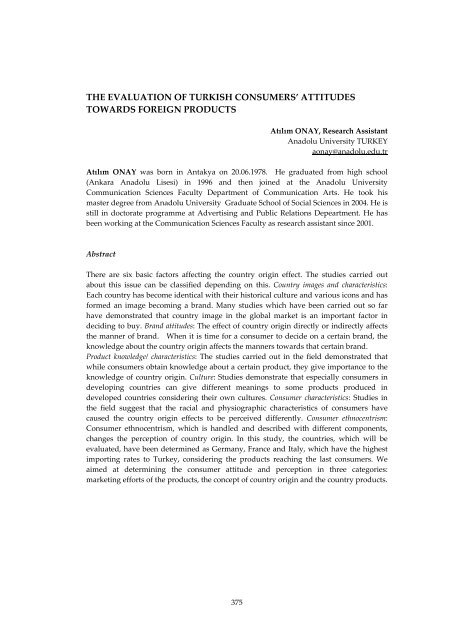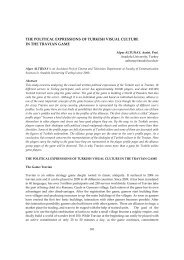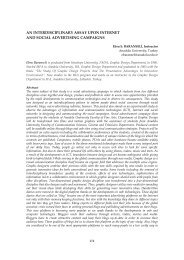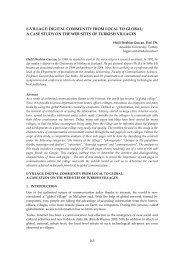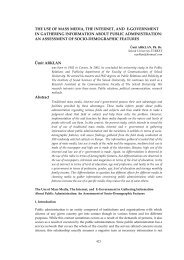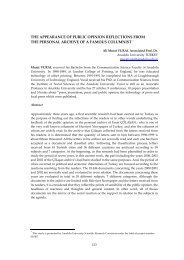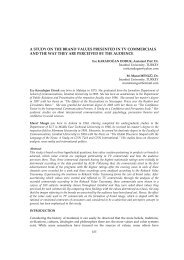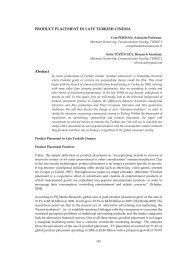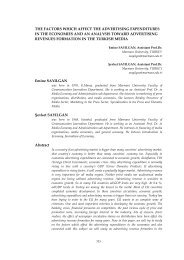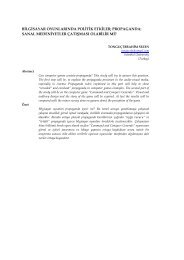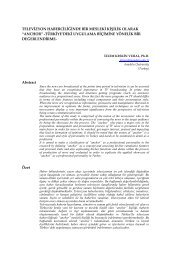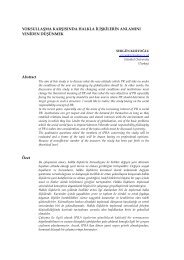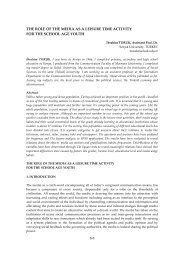the evaluation of turkish consumers' attitudes towards foreign products
the evaluation of turkish consumers' attitudes towards foreign products
the evaluation of turkish consumers' attitudes towards foreign products
You also want an ePaper? Increase the reach of your titles
YUMPU automatically turns print PDFs into web optimized ePapers that Google loves.
THE EVALUATION OF TURKISH CONSUMERS’ ATTITUDES<br />
TOWARDS FOREIGN PRODUCTS<br />
375<br />
Atılım ONAY, Research Assistant<br />
Anadolu University TURKEY<br />
aonay@anadolu.edu.tr<br />
Atılım ONAY was born in Antakya on 20.06.1978. He graduated from high school<br />
(Ankara Anadolu Lisesi) in 1996 and <strong>the</strong>n joined at <strong>the</strong> Anadolu University<br />
Communication Sciences Faculty Department <strong>of</strong> Communication Arts. He took his<br />
master degree from Anadolu University Graduate School <strong>of</strong> Social Sciences in 2004. He is<br />
still in doctorate programme at Advertising and Public Relations Depeartment. He has<br />
been working at <strong>the</strong> Communication Sciences Faculty as research assistant since 2001.<br />
Abstract<br />
There are six basic factors affecting <strong>the</strong> country origin effect. The studies carried out<br />
about this issue can be classified depending on this. Country images and characteristics:<br />
Each country has become identical with <strong>the</strong>ir historical culture and various icons and has<br />
formed an image becoming a brand. Many studies which have been carried out so far<br />
have demonstrated that country image in <strong>the</strong> global market is an important factor in<br />
deciding to buy. Brand <strong>attitudes</strong>: The effect <strong>of</strong> country origin directly or indirectly affects<br />
<strong>the</strong> manner <strong>of</strong> brand. When it is time for a consumer to decide on a certain brand, <strong>the</strong><br />
knowledge about <strong>the</strong> country origin affects <strong>the</strong> manners <strong>towards</strong> that certain brand.<br />
Product knowledge/ characteristics: The studies carried out in <strong>the</strong> field demonstrated that<br />
while consumers obtain knowledge about a certain product, <strong>the</strong>y give importance to <strong>the</strong><br />
knowledge <strong>of</strong> country origin. Culture: Studies demonstrate that especially consumers in<br />
developing countries can give different meanings to some <strong>products</strong> produced in<br />
developed countries considering <strong>the</strong>ir own cultures. Consumer characteristics: Studies in<br />
<strong>the</strong> field suggest that <strong>the</strong> racial and physiographic characteristics <strong>of</strong> consumers have<br />
caused <strong>the</strong> country origin effects to be perceived differently. Consumer ethnocentrism:<br />
Consumer ethnocentrism, which is handled and described with different components,<br />
changes <strong>the</strong> perception <strong>of</strong> country origin. In this study, <strong>the</strong> countries, which will be<br />
evaluated, have been determined as Germany, France and Italy, which have <strong>the</strong> highest<br />
importing rates to Turkey, considering <strong>the</strong> <strong>products</strong> reaching <strong>the</strong> last consumers. We<br />
aimed at determining <strong>the</strong> consumer attitude and perception in three categories:<br />
marketing efforts <strong>of</strong> <strong>the</strong> <strong>products</strong>, <strong>the</strong> concept <strong>of</strong> country origin and <strong>the</strong> country <strong>products</strong>.
THE EVALUATION OF TURKISH CONSUMERS’ ATTITUDES<br />
TOWARDS FOREIGN PRODUCTS<br />
Products are produced in “places” or any place ranging from a city to a state; in a<br />
country, in an area, in a continent or in <strong>the</strong> world as “global” <strong>products</strong>. This information<br />
about <strong>the</strong> place where <strong>the</strong> product is produced is called as country origin. Actually, a<br />
product or brand cannot be thought apart from <strong>the</strong> place where it was produced, in o<strong>the</strong>r<br />
words <strong>the</strong> country origin.<br />
The social changes and developments and economic changes in world history have also<br />
changed country origin effect and description. For example, <strong>the</strong> appearance <strong>of</strong> local<br />
cultures, <strong>the</strong> increase in <strong>the</strong> facilities <strong>of</strong> transportation, and <strong>the</strong> most importantly <strong>the</strong><br />
increase in <strong>the</strong> easiness <strong>of</strong> obtaining <strong>the</strong> desired information have also increased <strong>the</strong> effect<br />
<strong>of</strong> knowing about <strong>the</strong> country origin on consumption and communication studies.<br />
Consumers know about what <strong>products</strong> are better produced in which areas no more, and<br />
this case affects many factors ranging from brand preference to <strong>the</strong> money to be paid for<br />
a certain product.<br />
Products are not necessarily made in “countries”. They are made in “places”, or<br />
geographic origins, which can be anything from a city to a state or province, a country, a<br />
region, a continent-or <strong>the</strong> world, in <strong>the</strong> case <strong>of</strong> “global” <strong>products</strong>. Fur<strong>the</strong>r, unless viewed<br />
in strictly legal terms, “made-in” can mean manufactured-in but also assembled-,<br />
designed-, or invented-in, made by a producer whose domicile is-in, and <strong>of</strong>ten, wanting<br />
to lool like it was made-in . Lastly, “buyers and sellers” can be anything from industrial<br />
and consumer users <strong>of</strong> <strong>products</strong> to national governments courting each o<strong>the</strong>r in <strong>the</strong> hope<br />
<strong>of</strong> establishing closer trade relations. Since <strong>the</strong> “origin” images <strong>of</strong> “<strong>products</strong>” can have so<br />
many facets, it is no surprise that <strong>the</strong>y have been <strong>the</strong> object <strong>of</strong> study in disciplines ranging<br />
from political science to cultural anthropology and urban geography (Papadopoulos,<br />
Heslop, 1993).<br />
When we look from advertisers’ and advertising communicators’ point <strong>of</strong> view, it<br />
becomes an important datum to know about under which conditions <strong>the</strong> effect <strong>of</strong> country<br />
origin turns out to be an important factor. For instance, when a new communication<br />
strategy <strong>towards</strong> <strong>products</strong> or services is developed, <strong>the</strong> effect <strong>of</strong> country origin must be<br />
taken into consideration.<br />
The basic factors affecting <strong>the</strong> country origin<br />
When <strong>the</strong> literature in <strong>the</strong> field <strong>of</strong> country origin is carefully studied, it is seen that <strong>the</strong>re<br />
are six basic factors affecting <strong>the</strong> country origin effect. The studies carried out in <strong>the</strong> field<br />
can be classified depending on this; as country image and its characteristics, <strong>attitudes</strong><br />
<strong>towards</strong> trademarks, product knowledge/product properties, culture, consumer<br />
characteristics and consumer ethnocentrism.<br />
When country image and characteristics are mentioned, <strong>the</strong> first thing that we recall is<br />
that each country has been identified with different icons including each country’s<br />
historical culture and has created a country image being labeled as a trademark. Many<br />
studies having been carried out so far, have revealed that country image is an important<br />
factor affecting consumers’ choices in purchasing in today’s global market. Image is<br />
defined as “mental picture being formed as a result <strong>of</strong> a process <strong>of</strong> being informed”. With<br />
a clearer expression, it means evaluating <strong>the</strong> obtained knowledge and data, ranging from<br />
376
various channels to advertisement, from advertisements to natural contacts, from <strong>the</strong><br />
culture in which we live to <strong>the</strong> prejudices that we have (Özenç, 2002). The image in<br />
human mind about any product, trademark or country can be stated to be effective and<br />
determining in <strong>the</strong> <strong>attitudes</strong> and <strong>the</strong> behaviors <strong>of</strong> <strong>the</strong> consumers. In such cases in which<br />
no experience is available about product, consumers mostly determine some<br />
characteristics as <strong>the</strong>ir principals like <strong>the</strong> quality <strong>of</strong> <strong>the</strong> product, price, brand image,<br />
producer image, sales outlet image or country origin (Schiffman, Kanuk, 2004).<br />
Some countries have impressive reputation in some kinds <strong>of</strong> <strong>products</strong>; such as Japan in<br />
<strong>the</strong> field <strong>of</strong> automotive and electronic objects, USA in <strong>the</strong> field <strong>of</strong> advanced technological<br />
<strong>products</strong>, beverages, toys, cigarette and jeans, France in <strong>the</strong> field <strong>of</strong> wine, perfume,<br />
luxurious consumption <strong>products</strong>, are <strong>the</strong> countries having already deserved reputation.<br />
The fact that country image is mostly preferred and more impressive means that country<br />
origin has a more eye catching role in <strong>the</strong> introduction <strong>of</strong> a trademark and in labeling<br />
(Kotler, Jatusripitak & Maesince, 2002)<br />
Research (Schooler, 1965; Schooler & Wildt, 1968; Nagashima,1970; Darling, 1985;<br />
Johansson, Douglas, Nonaka, 1985; Hong & Wyer, 1990; Smith, 1993; Parameswaran &<br />
Pisharodi, 1994; Ahmed & dʹAstous, 1995) indicates that being perceived <strong>of</strong> a certain<br />
country by people affects <strong>the</strong> <strong>attitudes</strong> <strong>of</strong> people <strong>towards</strong> <strong>the</strong> <strong>products</strong> <strong>of</strong> that certain<br />
country. The characteristics <strong>of</strong> that country, <strong>the</strong> development level <strong>of</strong> that country in <strong>the</strong><br />
field <strong>of</strong> technology, democratic structure <strong>of</strong> it, <strong>the</strong> characteristics <strong>of</strong> <strong>the</strong> people <strong>of</strong> that<br />
country affect <strong>the</strong> perceptions <strong>towards</strong> that country. Research shows that positive<br />
impressions attributed to a certain country are mostly reflected to <strong>the</strong> <strong>products</strong> produced<br />
in that certain country; similarly negative impressions attributed to that country also<br />
affect <strong>the</strong> <strong>evaluation</strong> <strong>of</strong> <strong>the</strong> <strong>products</strong> <strong>of</strong> that country and <strong>attitudes</strong> <strong>of</strong> <strong>the</strong> people <strong>towards</strong><br />
<strong>the</strong> <strong>products</strong> <strong>of</strong> that country. From this point <strong>of</strong> view, <strong>the</strong> <strong>attitudes</strong> <strong>of</strong> <strong>the</strong> consumers<br />
<strong>towards</strong> <strong>the</strong> country in which <strong>the</strong> <strong>products</strong> are made and <strong>the</strong> knowledge <strong>of</strong> <strong>the</strong><br />
consumers about that country become an important datum for marketing experts and<br />
advertisers.<br />
The studies dealing with <strong>attitudes</strong> <strong>towards</strong> a trademark under <strong>the</strong> frame <strong>of</strong> country<br />
origin demonstrate that <strong>the</strong> effect <strong>of</strong> country origin has affected <strong>attitudes</strong> <strong>towards</strong><br />
trademark directly or indirectly (Han, 1990; Schaefer, 1995; Ahmed & at. Al, 2002). When<br />
deciding on a certain trademark is in question for a consumer, <strong>the</strong> knowledge about <strong>the</strong><br />
country origin affects <strong>the</strong> <strong>attitudes</strong> <strong>towards</strong> that trademark. At this point, <strong>the</strong><br />
development level <strong>of</strong> <strong>the</strong> countries appears as an important factor in shaping people’s<br />
<strong>attitudes</strong> <strong>towards</strong> trademarks. It is seen that <strong>the</strong> development level or reliability <strong>of</strong> a<br />
country help <strong>the</strong> <strong>products</strong> <strong>of</strong> that country to be perceived as developed and reliable<br />
trademarks. On <strong>the</strong> o<strong>the</strong>r hand, in <strong>the</strong> cases in which little knowledge is available about a<br />
certain trademark, <strong>the</strong> country origin effect appears as a factor in <strong>the</strong> formation <strong>of</strong><br />
<strong>attitudes</strong> <strong>towards</strong> that trademark.<br />
The studies carried out in <strong>the</strong> field <strong>of</strong> country origin indicate that consumers give<br />
importance to country origin when <strong>the</strong>y want to obtain knowledge about a product. In<br />
some product categories, <strong>the</strong> knowledge about <strong>the</strong> country origin seems to have priority<br />
over some properties like <strong>the</strong> price, warranty <strong>of</strong> <strong>the</strong> product in <strong>the</strong> <strong>evaluation</strong> <strong>of</strong> that<br />
trademark in people’s eyes.<br />
Culture appears to be an important factor in explaining consumer behaviors and in<br />
marketing activities. The effect <strong>of</strong> culture in people’s behaviors and its effect on consumer<br />
377
<strong>attitudes</strong> have been examined in many studies. Studies (Zhang, 1996; Canlı and<br />
Maheswaran, 2000; Parameswaran and Pisharodi, 2002) reveal that <strong>the</strong> consumers in<br />
developing countries attribute different meanings to <strong>the</strong> <strong>products</strong> made in developed<br />
countries. This causes consumers in developing countries to use <strong>the</strong> <strong>products</strong> made in<br />
developed countries as a sign <strong>of</strong> <strong>the</strong>ir social statue. In some cultures, it is observed that<br />
<strong>the</strong> use <strong>of</strong> native <strong>products</strong> is approved by <strong>the</strong> society.<br />
The country origin studies carried out to determine <strong>the</strong> characteristics <strong>of</strong> consumers<br />
(Chao and Gupta, 1995) demonstrate that demographic and physiographic properties <strong>of</strong><br />
<strong>the</strong> consumers have caused <strong>the</strong> effect <strong>of</strong> country origin to be perceived differently.<br />
Consumer ethnocentrism, which is handled and described with different elements, also<br />
alters <strong>the</strong> perception <strong>of</strong> <strong>the</strong> knowledge <strong>of</strong> country origin. In <strong>the</strong> cases in which consumer<br />
ethnocentrism is strong, it is observed that positive <strong>attitudes</strong> are developed and in <strong>the</strong><br />
cases in which consumer ethnocentrism is weak, it is observed that <strong>attitudes</strong> are formed<br />
with different factors.<br />
Problem<br />
In this study it is aimed to reveal <strong>the</strong> effect <strong>of</strong> country origin on Turkish consumers’<br />
<strong>attitudes</strong> and <strong>the</strong>ir perception. The <strong>attitudes</strong> and <strong>the</strong> perception <strong>of</strong> <strong>the</strong> consumers<br />
<strong>towards</strong> <strong>the</strong> countries where <strong>the</strong> target <strong>products</strong> are made are unknown; <strong>the</strong> <strong>attitudes</strong><br />
and <strong>the</strong> perception <strong>of</strong> those <strong>foreign</strong> countries <strong>towards</strong> <strong>the</strong>ir marketing activities are also<br />
unknown. Besides, <strong>the</strong>re is no data showing how <strong>the</strong> country origin is important in <strong>the</strong><br />
process <strong>of</strong> purchasing.<br />
Purpose<br />
With this study, <strong>the</strong> effect <strong>of</strong> country origin on Turkish consumers’ <strong>attitudes</strong> and<br />
perception will be tried to bring to light in a descriptive way.<br />
The possible answers for <strong>the</strong> following questions will be looked for in parallelism to <strong>the</strong><br />
purpose <strong>of</strong> <strong>the</strong> study.<br />
1. What are <strong>the</strong> Turkish consumers’ <strong>attitudes</strong> <strong>towards</strong> <strong>the</strong> <strong>products</strong> made in<br />
Germany, Italy and France?<br />
2. What are <strong>the</strong> Turkish consumers’ <strong>attitudes</strong> <strong>towards</strong> <strong>the</strong> marketing activities <strong>of</strong> <strong>the</strong><br />
<strong>products</strong> made in Germany, Italy and France?<br />
3. What are <strong>the</strong> <strong>attitudes</strong> <strong>of</strong> Turkish consumers <strong>towards</strong> <strong>the</strong> country origin <strong>of</strong> <strong>the</strong><br />
<strong>products</strong>?<br />
4. Is <strong>the</strong>re any difference among Turkish consumers’ <strong>attitudes</strong> <strong>towards</strong> <strong>the</strong> <strong>products</strong><br />
produced in Germany, Italy and France?<br />
5. Is <strong>the</strong>re any difference among Turkish consumers’ <strong>attitudes</strong> <strong>towards</strong> <strong>the</strong> marketing<br />
activities <strong>of</strong> <strong>the</strong> <strong>products</strong> made in Germany, Italy and France?<br />
6. Is <strong>the</strong>re any difference among Turkish consumers’ <strong>attitudes</strong> <strong>towards</strong> <strong>the</strong> origin <strong>of</strong><br />
Germany, Italy and France?<br />
7. Is <strong>the</strong>re any relation between <strong>the</strong> <strong>attitudes</strong> <strong>of</strong> Turkish consumers <strong>towards</strong> <strong>the</strong><br />
<strong>products</strong> made in Germany, Italy and France, <strong>the</strong> <strong>attitudes</strong> <strong>of</strong> Turkish consumers<br />
<strong>towards</strong> <strong>the</strong> marketing activities <strong>of</strong> <strong>the</strong>se <strong>products</strong>, <strong>the</strong> <strong>attitudes</strong> <strong>towards</strong> <strong>the</strong><br />
importance <strong>of</strong> country origin, gender and <strong>the</strong> amount <strong>of</strong> <strong>the</strong>ir income?<br />
378
8. Is <strong>the</strong>re any relation between <strong>the</strong> <strong>attitudes</strong> <strong>of</strong> Turkish consumers <strong>towards</strong> <strong>the</strong><br />
<strong>products</strong> made in Germany, Italy and France, <strong>the</strong> <strong>attitudes</strong> <strong>towards</strong> <strong>the</strong> marketing<br />
activities <strong>of</strong> <strong>the</strong>se <strong>products</strong> and <strong>the</strong> <strong>attitudes</strong> <strong>towards</strong> <strong>the</strong> importance <strong>of</strong> country<br />
origin?<br />
Limitations<br />
The limitations, which may affect <strong>the</strong> generalization <strong>of</strong> <strong>the</strong> research findings, can be<br />
stated as follows:<br />
1. The study is limited to only three countries, Germany, Italy and France. These three<br />
countries have been chosen depending on <strong>the</strong> data <strong>of</strong> <strong>the</strong> external trading duties<br />
undersecretary. In <strong>the</strong> categories chosen depending on <strong>the</strong> data <strong>of</strong> <strong>the</strong> year, 2003<br />
(o<strong>the</strong>r foodstuffs; drinks, tobacco and its <strong>products</strong>; <strong>products</strong> <strong>of</strong> automotive<br />
industry; <strong>of</strong>fice machines and communication systems; o<strong>the</strong>r machines and<br />
transportation means; <strong>the</strong> <strong>products</strong> <strong>of</strong> textile industry; ready –made clothing; o<strong>the</strong>r<br />
consumption properties), Germany, Italy and France are <strong>the</strong> countries which<br />
imported <strong>the</strong> most <strong>products</strong>. The choice <strong>of</strong> product categories has been done<br />
considering <strong>the</strong> latest <strong>products</strong> reaching consumers.<br />
2. The participants <strong>of</strong> <strong>the</strong> study consist <strong>of</strong> <strong>the</strong> students from Communication Sciences<br />
Faculty at Anadolu University<br />
METHOD<br />
The descriptive method, in which an already existing case is studied, is used in <strong>the</strong> study<br />
with <strong>the</strong> use <strong>of</strong> questionnaire, observation and interviews.<br />
The participants have been chosen as <strong>the</strong> 2003-2004 fall –term students at communication<br />
Sciences faculty at Anadolu University. To choose <strong>the</strong> participants <strong>of</strong> <strong>the</strong> study, all <strong>the</strong><br />
teaching schedules are taken and all <strong>the</strong> courses having more than 30 attending students<br />
are listed. Using this list, participants are chosen randomly. The questionnaire is applied<br />
to 178 students in total as 94 male and 84 female.<br />
Data and Data Collection<br />
Attitude scale for country <strong>products</strong>, <strong>the</strong> marketing activities <strong>of</strong> <strong>the</strong>se <strong>products</strong> and <strong>the</strong> importance<br />
<strong>of</strong> country origin: <strong>the</strong> attitude scale developed by darling and Puetz and consisting <strong>of</strong> 31<br />
items, is used in <strong>the</strong> study. In <strong>the</strong> scale, five –likert- scale is used. (1= strongly agree, 2=<br />
agree, 3= no idea, 4= disagree, 5= strongly disagree). The scale consists <strong>of</strong> <strong>the</strong>e main parts.<br />
The items numbered between 1 and 13 aim to measure <strong>the</strong> consumers’ <strong>attitudes</strong> <strong>towards</strong><br />
<strong>the</strong> marketing activities <strong>of</strong> <strong>the</strong> <strong>products</strong> <strong>of</strong> <strong>the</strong> chosen countries. The items numbered<br />
between 14 and 26 aim to measure <strong>the</strong> <strong>attitudes</strong> <strong>of</strong> <strong>the</strong> <strong>products</strong> <strong>of</strong> <strong>the</strong> chosen countries<br />
<strong>towards</strong> <strong>the</strong> marketing activities. The items 14 and 15 are about services, 16 and 17 are<br />
about packaging, 18 and 19 are about pricing, 20 is about <strong>the</strong> name <strong>of</strong> trademark, 21 and<br />
22 are about outlets, 23 is about <strong>the</strong> locations <strong>of</strong> <strong>the</strong> outlets, 24, 25 and 26 are about<br />
advertising and promotions. The items numbered between 27 and 31 aim to measure <strong>the</strong><br />
importance <strong>of</strong> <strong>the</strong> knowledge <strong>of</strong> country origin.<br />
379
All data is transferred to “SPSS (Statistical Package for Social Sciences) for windows 11.0”<br />
and using this programme, data is analyzed. The analyses used in <strong>the</strong> <strong>evaluation</strong> <strong>of</strong> <strong>the</strong><br />
data are frequency analysis, T-test, one-way variance analysis and correlation analysis.<br />
In <strong>the</strong> piloting carried out after completing <strong>the</strong> conversion <strong>of</strong> <strong>the</strong> scale, <strong>the</strong> Alfa reliability<br />
level is found to be .82.<br />
As a consequence <strong>of</strong> factor analysis, <strong>the</strong> 31-item-scale is lowered to 26 revising some<br />
items. The scale is applied to 178 participants in total as 84 female and 94 male.<br />
RESULTS AND DISCUSSION<br />
Table I: Attitudes <strong>towards</strong> German, Italian and French <strong>products</strong> and <strong>the</strong>ir standard<br />
deviations.<br />
The <strong>products</strong> produced in ……….<br />
are favorable for <strong>the</strong> needs <strong>of</strong> Turkish<br />
consumers.<br />
The <strong>products</strong> made in ……… have a<br />
competitive advantage compared<br />
with those made in o<strong>the</strong>r countries.<br />
The <strong>products</strong> made in …….are made<br />
with <strong>the</strong> greatest <strong>of</strong> care and have<br />
better workmanship.<br />
In recent years, <strong>the</strong> <strong>products</strong> made in<br />
………..seem to have had an increase<br />
in <strong>the</strong>ir qualities.<br />
The <strong>products</strong> made in ……. have<br />
made great progress in <strong>the</strong> use <strong>of</strong><br />
advanced technology.<br />
The <strong>products</strong> made in …… lacks <strong>of</strong><br />
creativity and looks like <strong>the</strong> <strong>products</strong><br />
made in o<strong>the</strong>r countries.<br />
The <strong>products</strong> made in ……… have<br />
many alternatives.<br />
The <strong>products</strong> made in ……. are<br />
produced by <strong>the</strong> companies <strong>the</strong><br />
primary concern <strong>of</strong> which is <strong>the</strong><br />
physical appearance <strong>of</strong> <strong>the</strong> <strong>products</strong><br />
ra<strong>the</strong>r than <strong>the</strong>ir performances.<br />
The <strong>products</strong> made in ……… have<br />
been produced very wisely with<br />
regards to <strong>the</strong>ir color and design.<br />
The <strong>products</strong> made in …….are mostly<br />
reliable and seem to be long-lasting.<br />
GERMANY ITALY FRANCE<br />
380<br />
2,5506<br />
(,96271)<br />
2,2697<br />
(,99449)<br />
2,3202<br />
(1,00492)<br />
2,7191<br />
(,88922)<br />
2,1629<br />
(,88386)<br />
3,1067<br />
(1,11226)<br />
2,4719<br />
(,98680)<br />
3,2697<br />
(1,04437)<br />
2,4719<br />
(,95183)<br />
2,0449<br />
(,92559)<br />
2,7978<br />
(,91045)<br />
2,5506<br />
(,87671)<br />
2,5787<br />
(,90635)<br />
2,6292<br />
(,85545)<br />
2,6348<br />
(,80698)<br />
3,3146<br />
(1,00951)<br />
2,3933<br />
(,92813)<br />
2,8483<br />
(,98263)<br />
2,2865<br />
(,85829)<br />
2,5899<br />
(,82702)<br />
3,1404<br />
(,86190)<br />
2,7022<br />
(,95438)<br />
2,6404<br />
(,86026)<br />
2,8090<br />
(,82854)<br />
2,6067<br />
(,81813)<br />
3,2865<br />
(,98688)<br />
2,4888<br />
(,90970)<br />
2,8371<br />
(1,02034)<br />
2,3708<br />
(,86203)<br />
2,6011<br />
(,85925)
The <strong>products</strong> made in …… are for<br />
luxurious consumption ra<strong>the</strong>r than for<br />
basic needs, as <strong>the</strong>ir structures<br />
require.<br />
381<br />
3,0674<br />
(,98918)<br />
2,6124<br />
(1,00915)<br />
2,4213<br />
(1,06670)<br />
When <strong>the</strong> averages <strong>of</strong> <strong>the</strong> <strong>attitudes</strong> <strong>towards</strong> <strong>the</strong> <strong>products</strong> made in <strong>the</strong> chosen countries<br />
are examined, most <strong>of</strong> <strong>the</strong> values seem to be close to 3. In addition, for <strong>the</strong> statement <strong>of</strong><br />
“The <strong>products</strong> made in ….. generally lacks <strong>of</strong> creativity and looks like <strong>the</strong> <strong>products</strong> made<br />
in o<strong>the</strong>r countries”, it seems that averages in three countries seem to be higher than 3. At<br />
<strong>the</strong> same time, <strong>the</strong> standard deviations <strong>of</strong> <strong>the</strong> values given for <strong>the</strong> above mentioned<br />
statement are found to be higher than 1.<br />
Table II: The averages <strong>of</strong> <strong>the</strong> <strong>attitudes</strong> <strong>of</strong> <strong>the</strong> three countries’ <strong>products</strong> <strong>towards</strong> marketing<br />
activities and <strong>the</strong>ir standard deviations.<br />
In general, <strong>the</strong> care and repair<br />
services provided for <strong>the</strong> <strong>products</strong><br />
made in …….. are adequate.<br />
The packages <strong>of</strong> <strong>the</strong> <strong>products</strong> made<br />
in …….. have been designed well<br />
and every size is available.<br />
The etiquettes and <strong>the</strong> manuals <strong>of</strong><br />
<strong>the</strong> <strong>products</strong> made in ……..<br />
comprehensible and informative.<br />
The <strong>products</strong> made in ……. are<br />
cheaper when compared with those<br />
made in o<strong>the</strong>r countries.<br />
The brands <strong>of</strong> <strong>the</strong> <strong>products</strong> made in<br />
…….. are easily recognized and<br />
well-known.<br />
The <strong>products</strong> made in …….. can be<br />
easily found at outlets.<br />
The retails selling <strong>the</strong> <strong>products</strong> made<br />
in ……… have a good reputation.<br />
The <strong>products</strong> made in ……. are<br />
mostly exhibited well and sold at<br />
retails.<br />
The advertisements <strong>of</strong> <strong>the</strong> <strong>products</strong><br />
made in ………… are generally<br />
persuasive and provide a reliable<br />
source <strong>of</strong> knowledge about <strong>the</strong><br />
product.<br />
The <strong>products</strong> made in ……… need<br />
more advertisements and promotion<br />
to better inform consumers about<br />
<strong>the</strong> presence <strong>of</strong> <strong>the</strong> product.<br />
ALMANYA İTALYA FRANSA<br />
2,1966<br />
(,93313)<br />
2,5393<br />
(,80333)<br />
2,6011<br />
(1,07009)<br />
3,0337<br />
(1,18798)<br />
2,0674<br />
(,97769)<br />
2,1910<br />
(,89413)<br />
2,3708<br />
(,87504)<br />
2,3764<br />
(,90754)<br />
2,3539<br />
(,91040)<br />
3,0000<br />
(1,03607)<br />
2,6348<br />
(,86770)<br />
2,5562<br />
(,73622)<br />
2,7753<br />
(,98294)<br />
3,4101<br />
(,91769)<br />
2,3258<br />
(,95994)<br />
2,6292<br />
(,85545)<br />
2,4888<br />
(,90970)<br />
2,4438<br />
(,88279)<br />
2,6292<br />
(,85545)<br />
2,6236<br />
(,93815)<br />
2,6124<br />
(,84457)<br />
2,6517<br />
(,78259)<br />
2,8483<br />
(1,05473)<br />
3,4944<br />
(,99290)<br />
2,4494<br />
(,96856)<br />
2,7247<br />
(,90670)<br />
2,5281<br />
(,88413)<br />
2,4326<br />
(,90726)<br />
2,6180<br />
(,89576)<br />
2,5843<br />
(1,02851)
When we examine <strong>the</strong> averages <strong>of</strong> <strong>the</strong> <strong>attitudes</strong> <strong>of</strong> <strong>the</strong> three countries’ <strong>products</strong> <strong>towards</strong> marketing<br />
activities for <strong>the</strong> statement <strong>of</strong> “The <strong>products</strong> made in ……. are cheaper when compared with<br />
those made in o<strong>the</strong>r countries.” <strong>the</strong> averages for <strong>the</strong> three countries seem to be above 3. At <strong>the</strong><br />
same time, <strong>the</strong> standard deviations <strong>of</strong> <strong>the</strong> values given to <strong>the</strong> above mentioned statement seem to<br />
be above 1<br />
Table III: The averages <strong>of</strong> <strong>attitudes</strong> <strong>towards</strong> <strong>the</strong> importance <strong>of</strong> country origin <strong>of</strong> <strong>the</strong><br />
<strong>products</strong> <strong>of</strong> <strong>the</strong> countries.<br />
When I go shopping, I usually show<br />
interest to <strong>the</strong> <strong>products</strong> made in ........<br />
The fact that I use <strong>the</strong> <strong>products</strong> made<br />
in .......... for <strong>the</strong> purpose <strong>of</strong><br />
comparison helps me to wisely choose<br />
what I should buy.<br />
As much as possible, I prefer to buy<br />
<strong>the</strong> <strong>products</strong> made in .........<br />
When I compare with o<strong>the</strong>r<br />
countries, I am not pleased with <strong>the</strong><br />
<strong>products</strong> made in ...........<br />
I am proud <strong>of</strong> myself to have <strong>the</strong><br />
<strong>products</strong> made in ...........<br />
ALMANYA İTALYA FRANSA<br />
3,0843<br />
(1,22529)<br />
2,8708<br />
(1,08411)<br />
3,1067<br />
(1,31693)<br />
2,7360<br />
(,99884)<br />
3,6573<br />
(1,32787)<br />
382<br />
3,0787<br />
(1,21873)<br />
3,0899<br />
(,93447)<br />
3,2921<br />
(1,22315)<br />
2,7640<br />
(,95103)<br />
3,7135<br />
(1,27201)<br />
3,3202<br />
(1,15163)<br />
3,1573<br />
(,92546)<br />
3,4157<br />
(1,13803)<br />
2,8090<br />
(,90043)<br />
3,7809<br />
(1,20839)<br />
When we examine <strong>the</strong> averages <strong>of</strong> <strong>the</strong> <strong>attitudes</strong> <strong>towards</strong> <strong>the</strong> importance <strong>of</strong> <strong>the</strong> country<br />
origin <strong>of</strong> <strong>the</strong> chosen countries, for <strong>the</strong> statement <strong>of</strong> “When I go shopping, I usually show<br />
interest to <strong>the</strong> <strong>products</strong> made in .............” <strong>the</strong> averages for <strong>the</strong> three countries seem to be<br />
above 3. At <strong>the</strong> same time, <strong>the</strong> standard deviations <strong>of</strong> <strong>the</strong> values given to <strong>the</strong> abovementioned<br />
statement seem to be above 1.<br />
For <strong>the</strong> statement <strong>of</strong> “ <strong>the</strong> fact that I use <strong>the</strong> <strong>products</strong> made in .......... for <strong>the</strong> purpose <strong>of</strong><br />
comparison helps me to wisely choose what I should buy”, The average <strong>of</strong> Germany is<br />
below 3 and <strong>the</strong> averages <strong>of</strong> France and Italy are above 3.The standard deviation for<br />
Germany is above 1, and For France and Italy, it is below 1.<br />
For <strong>the</strong> statement <strong>of</strong> “I am proud <strong>of</strong> myself to have <strong>the</strong> <strong>products</strong> made in ...........”, <strong>the</strong><br />
averages <strong>of</strong> <strong>the</strong> three countries seem to be above 3.5. The standard deviation <strong>of</strong> <strong>the</strong> values<br />
given to this statement is above 1.<br />
Gender<br />
In this phase, <strong>the</strong> connection between <strong>the</strong> overall <strong>attitudes</strong> <strong>towards</strong> gender, <strong>the</strong> <strong>products</strong><br />
made in <strong>the</strong>se three countries, <strong>the</strong> marketing activities <strong>of</strong> <strong>the</strong>se <strong>products</strong>, <strong>the</strong> importance<br />
<strong>of</strong> <strong>the</strong> country origin and overall <strong>attitudes</strong> is analyzed with <strong>the</strong> use <strong>of</strong> T-test.<br />
As a result <strong>of</strong> <strong>the</strong> test, a significant connection has been found between <strong>the</strong> overall<br />
<strong>attitudes</strong> <strong>of</strong> <strong>the</strong> three categories made in Germany and gender. As can be seen in <strong>the</strong><br />
group statistics, <strong>the</strong> proportion <strong>of</strong> <strong>the</strong> overall <strong>attitudes</strong> <strong>of</strong> <strong>the</strong> female participants (71,8214)<br />
<strong>towards</strong> <strong>the</strong> <strong>products</strong> made in Germany, when compared with that <strong>of</strong> male participants
(65,3441), <strong>the</strong>ir <strong>attitudes</strong> <strong>towards</strong> <strong>the</strong> marketing activities <strong>of</strong> <strong>the</strong>se <strong>products</strong> and <strong>the</strong>ir<br />
<strong>attitudes</strong> <strong>towards</strong> <strong>the</strong> country origin can be stated to more negative.<br />
The analysis <strong>of</strong> <strong>the</strong> overall <strong>attitudes</strong> <strong>towards</strong> country origin, <strong>the</strong> marketing activities <strong>of</strong><br />
<strong>the</strong>se <strong>products</strong> and <strong>the</strong> <strong>products</strong>.<br />
The overall <strong>attitudes</strong> <strong>towards</strong> <strong>the</strong> <strong>products</strong> made in <strong>the</strong>se three countries, <strong>the</strong> marketing<br />
activities <strong>of</strong> <strong>the</strong>se <strong>products</strong> and <strong>the</strong>ir country origin have been investigated with <strong>the</strong> use<br />
<strong>of</strong> one-way variance analysis method. Then, <strong>the</strong> connections among <strong>the</strong> <strong>attitudes</strong> <strong>towards</strong><br />
<strong>the</strong> importance <strong>of</strong> <strong>the</strong> country origin, <strong>the</strong> marketing activities <strong>of</strong> <strong>the</strong> <strong>products</strong> made in<br />
<strong>the</strong>se countries and <strong>the</strong> amount <strong>of</strong> income and country <strong>products</strong> have been investigated.<br />
When <strong>the</strong> overalls <strong>of</strong> <strong>the</strong> <strong>attitudes</strong> <strong>towards</strong> <strong>the</strong> <strong>products</strong> made in Germany, Italy and<br />
France are evaluated, it can be stated that <strong>the</strong>se three countries differed in <strong>the</strong> <strong>evaluation</strong>.<br />
In this respect, it can be stated that consumers have different <strong>attitudes</strong> and perceptions<br />
<strong>towards</strong> <strong>the</strong> <strong>products</strong> <strong>of</strong> <strong>the</strong>se three countries, <strong>the</strong> marketing activities <strong>of</strong> <strong>the</strong>se <strong>products</strong><br />
and <strong>the</strong> country origin.<br />
Income<br />
As a result <strong>of</strong> <strong>the</strong> ANOVA analysis, a significant connection has been established<br />
between <strong>the</strong> <strong>attitudes</strong> <strong>towards</strong> <strong>the</strong> marketing activities <strong>of</strong> <strong>the</strong> <strong>products</strong> made in Germany<br />
(overall for marketing in Germany), <strong>the</strong> <strong>attitudes</strong> <strong>towards</strong> <strong>the</strong> marketing activities <strong>of</strong> <strong>the</strong><br />
<strong>products</strong> made in Italy (overall for marketing in Italy) and <strong>the</strong> amount <strong>of</strong> income <strong>of</strong> <strong>the</strong><br />
participants. For o<strong>the</strong>r countries, no significant connection has been found.<br />
The correlations among <strong>the</strong> <strong>attitudes</strong> <strong>towards</strong> <strong>the</strong> <strong>products</strong>, <strong>the</strong> marketing activities <strong>of</strong><br />
<strong>the</strong> <strong>products</strong> and <strong>the</strong> importance <strong>of</strong> country origin.<br />
At this phase, <strong>the</strong> relations among <strong>the</strong> <strong>attitudes</strong> <strong>towards</strong> <strong>the</strong> <strong>products</strong> made in <strong>the</strong><br />
country, <strong>the</strong> marketing activities <strong>of</strong> <strong>the</strong> <strong>products</strong> and <strong>the</strong> importance <strong>of</strong> <strong>the</strong> country origin<br />
have been investigated with <strong>the</strong> use <strong>of</strong> correlation analysis.<br />
In almost all <strong>of</strong> <strong>the</strong> <strong>evaluation</strong>s, a connection has been determined. This connection can<br />
be described as a positive connection. The strong connection among <strong>the</strong> stated <strong>attitudes</strong><br />
indicates that <strong>the</strong> participants have utilized both <strong>attitudes</strong> similarly. Any participant<br />
utilizing any <strong>of</strong> <strong>the</strong> stated <strong>attitudes</strong> as positive has also utilized <strong>the</strong> second attitude as<br />
positive; if negative, <strong>the</strong> second one is also utilized as negative, if <strong>the</strong> participant is<br />
neutral for any <strong>of</strong> <strong>the</strong> <strong>attitudes</strong>, s/he is also neutral for <strong>the</strong> second attitude.<br />
The Averages <strong>of</strong> <strong>the</strong> <strong>attitudes</strong> <strong>towards</strong> <strong>the</strong> importance <strong>of</strong> country origin, <strong>the</strong> marketing<br />
activities <strong>of</strong> <strong>the</strong> <strong>products</strong>, <strong>products</strong> and <strong>the</strong> averages <strong>of</strong> <strong>the</strong> <strong>attitudes</strong> <strong>of</strong> all categories.<br />
In this part, <strong>the</strong> averages <strong>of</strong> <strong>the</strong> <strong>attitudes</strong> <strong>towards</strong> <strong>the</strong> importance <strong>of</strong> country origin, <strong>the</strong><br />
marketing activities <strong>of</strong> <strong>the</strong> <strong>products</strong>, <strong>products</strong> and <strong>of</strong> all categories are investigated. It can<br />
be stated that <strong>the</strong> general <strong>attitudes</strong> <strong>towards</strong> <strong>the</strong> <strong>products</strong> made in Germany are more<br />
positive than those <strong>of</strong> France and Italy. It can also be stated that <strong>the</strong> <strong>attitudes</strong> <strong>towards</strong> <strong>the</strong><br />
marketing activities <strong>of</strong> <strong>the</strong> <strong>products</strong> made in Germany are more positive than those <strong>of</strong> <strong>the</strong><br />
<strong>products</strong> made in France and Italy. It can be stated that participants have similar<br />
<strong>evaluation</strong>s about <strong>the</strong> countries with regards to <strong>the</strong>ir <strong>attitudes</strong> <strong>towards</strong> <strong>the</strong> importance <strong>of</strong><br />
383
country origin. In spite <strong>of</strong> this, Germany seems to have been evaluated more positively in<br />
terms <strong>of</strong> <strong>the</strong> <strong>attitudes</strong> <strong>towards</strong> <strong>the</strong> importance <strong>of</strong> country origin.<br />
With regards to <strong>the</strong> overalls, Germany has been determined as <strong>the</strong> most positively<br />
evaluated country out <strong>of</strong> <strong>the</strong> three countries. Italy is <strong>the</strong> next and <strong>the</strong>n France comes.<br />
RESULTS AND SUGGESTIONS.<br />
This study is a descriptive research aiming to reveal <strong>the</strong> <strong>attitudes</strong> <strong>towards</strong> <strong>the</strong> <strong>products</strong><br />
made in Germany, France and Italy, <strong>the</strong> marketing activities <strong>of</strong> <strong>the</strong> <strong>products</strong> and <strong>the</strong><br />
importance <strong>of</strong> country origin.<br />
The results <strong>of</strong> <strong>the</strong> study suggests that participants evaluated <strong>the</strong> <strong>products</strong> made in<br />
Germany as appropriate for <strong>the</strong> needs <strong>of</strong> Turkish consumers, having a competitive<br />
advantage when compared with <strong>the</strong> <strong>products</strong> made in o<strong>the</strong>r countries, carefully<br />
produced and having better workmanship, showing great progress in <strong>the</strong> use <strong>of</strong><br />
advanced technology, having many alternatives in models, being used very wisely with<br />
regards to <strong>the</strong> use <strong>of</strong> color and design, reliable and long-lasting.<br />
Participants evaluated <strong>the</strong> <strong>products</strong> made in Italy as having a competitive advantage<br />
compared with <strong>the</strong> <strong>products</strong> made in o<strong>the</strong>r countries, carefully produced and having a<br />
better workmanship, having many alternatives in models, being utilized carefully with<br />
regards to color and design, for luxurious consumption ra<strong>the</strong>r than for basic needs as<br />
<strong>the</strong>ir structures required.<br />
Participants evaluated <strong>the</strong> <strong>products</strong> made in France as having competitive advantage<br />
compared with <strong>the</strong> <strong>products</strong> made in o<strong>the</strong>r countries, carefully produced and having<br />
better workmanship, having many alternatives in models, being used very wisely in<br />
terms <strong>of</strong> color and design, reliable and long lasting, for luxurious consumption ra<strong>the</strong>r<br />
than for basic needs as <strong>the</strong>ir structures required.<br />
When <strong>the</strong> <strong>attitudes</strong> and perceptions <strong>towards</strong> <strong>the</strong> marketing activities <strong>of</strong> <strong>the</strong> <strong>products</strong><br />
made in Italy, France and Germany are examined; participants evaluated <strong>the</strong> marketing<br />
activities <strong>of</strong> <strong>the</strong> <strong>products</strong> made in Germany as sufficient with regards to caring and<br />
repairing services provided by <strong>the</strong> seller, having a clear and informative etiquette and<br />
manual, having an easily recognized brand and known well, being easily available at<br />
retails, having retails with good reputation, exhibiting <strong>the</strong> <strong>products</strong> and selling well,<br />
advertising <strong>the</strong> <strong>products</strong> in a persuasive way and giving a reliable source <strong>of</strong> knowledge.<br />
Participants evaluated <strong>the</strong> marketing activities <strong>of</strong> <strong>the</strong> <strong>products</strong> made in Italy as having<br />
easily recognized and well known <strong>products</strong>, having retails which have good reputation,<br />
exhibiting and selling <strong>the</strong> <strong>products</strong> well at retails, and consumers also stated that <strong>the</strong>y<br />
need to be informed about <strong>the</strong> <strong>products</strong> with more promotion and advertisements.<br />
Participants evaluated <strong>the</strong> marketing activities <strong>of</strong> <strong>the</strong> <strong>products</strong> made in France as having<br />
easily recognized and well known <strong>products</strong>, exhibiting and selling <strong>the</strong> <strong>products</strong> well at<br />
outlet stores, and <strong>the</strong>y also stated that <strong>the</strong>y need to be informed about <strong>the</strong> <strong>products</strong> with<br />
more promotion and advertisements.<br />
When participants’ <strong>attitudes</strong> <strong>towards</strong> <strong>the</strong> importance <strong>of</strong> country origin, it is seen that no<br />
significant view has appeared. The proportions <strong>of</strong> <strong>the</strong> participants evaluating as negative,<br />
384
positive and neutral seem to be very close to one ano<strong>the</strong>r. On <strong>the</strong> o<strong>the</strong>r hand, <strong>the</strong> item<br />
which states that “I am proud <strong>of</strong> having <strong>the</strong> <strong>products</strong> made in……..” has been evaluated<br />
negatively for <strong>the</strong> three <strong>of</strong> <strong>the</strong> countries. This case can be justified with consumer<br />
ethnocentrism. In <strong>the</strong> related literature, it is found that <strong>the</strong> characteristics <strong>of</strong> <strong>the</strong><br />
consumer ethnocentrism may differ among <strong>the</strong> consumers living in cities. When we<br />
consider that this study was carried out on a group <strong>of</strong> people living in Eskişehir and<br />
studying <strong>the</strong>re, it can be stated that <strong>the</strong>se characteristics could affect <strong>the</strong> <strong>evaluation</strong> <strong>of</strong> <strong>the</strong><br />
country origin.<br />
Although no significant connection has been found between <strong>the</strong> questioned <strong>attitudes</strong>,<br />
perception and gender, it is seen that <strong>the</strong> female participants in Germany had a more<br />
negative <strong>evaluation</strong> compared with that <strong>of</strong> male participants.<br />
As a result <strong>of</strong> ANOVA analysis, it was found that participants evaluated each country<br />
differently from <strong>the</strong> o<strong>the</strong>rs. The fact that each <strong>of</strong> <strong>the</strong> evaluated countries is a developed<br />
European country did not stop <strong>the</strong> <strong>evaluation</strong>s from differing from one ano<strong>the</strong>r.<br />
Likewise, when <strong>the</strong> related literature was examined, it was seen that <strong>the</strong> <strong>products</strong> <strong>of</strong> <strong>the</strong><br />
developed countries have been found to be evaluated positively. Although <strong>the</strong> countries<br />
have been evaluated differently in this study, most <strong>of</strong> <strong>the</strong> participants in three countries<br />
ei<strong>the</strong>r had positive <strong>evaluation</strong>s or were neutral in <strong>the</strong> three <strong>of</strong> <strong>the</strong> investigated categories.<br />
As a result <strong>of</strong> <strong>the</strong> ANOVA analysis, <strong>the</strong> only connection found in <strong>the</strong> study is between <strong>the</strong><br />
<strong>attitudes</strong>/perceptions <strong>towards</strong> <strong>the</strong> marketing activities <strong>of</strong> <strong>the</strong> <strong>products</strong> made in Germany<br />
and Italy and <strong>the</strong> amount <strong>of</strong> income <strong>of</strong> <strong>the</strong> participants. No significant connection was<br />
found between <strong>the</strong> <strong>attitudes</strong>/perceptions <strong>of</strong> <strong>the</strong> o<strong>the</strong>r country and category and <strong>the</strong><br />
amount <strong>of</strong> income <strong>of</strong> <strong>the</strong> participants. In this respect, as participants’ income increases, it<br />
can be stated that <strong>the</strong> <strong>attitudes</strong> and perceptions <strong>towards</strong> <strong>the</strong> marketing activities <strong>of</strong> <strong>the</strong><br />
<strong>products</strong> made in Italy and Germany may change negatively. This case can be justified<br />
with <strong>the</strong> parallelism between <strong>the</strong> amounts <strong>of</strong> <strong>the</strong> income <strong>of</strong> <strong>the</strong> participants and<br />
purchasing <strong>the</strong> product. As income increases, consumers may have <strong>the</strong> <strong>products</strong> and thus<br />
<strong>the</strong>y may have <strong>the</strong> chance to try <strong>the</strong> product directly. In such a case, <strong>the</strong> importance <strong>of</strong><br />
some facts influencing <strong>the</strong> <strong>evaluation</strong> <strong>of</strong> <strong>the</strong> <strong>products</strong> like country origin will decrease.<br />
The <strong>attitudes</strong>/perceptions consumers have before buying a certain product and after<br />
buying that product may be stated to be different.<br />
In <strong>the</strong> crosswise table prepared for <strong>the</strong> purpose <strong>of</strong> establishing relations among all <strong>the</strong><br />
categories, each attitude and perception category for each country has been found to be<br />
related to one ano<strong>the</strong>r. In this case, it can be stated that <strong>the</strong> participants have done <strong>the</strong>ir<br />
<strong>evaluation</strong>s relating to <strong>the</strong> three countries. The fact that three <strong>of</strong> <strong>the</strong> countries are<br />
European countries can be stated to have affected <strong>the</strong> result. It was observed that<br />
participants have evaluated each country in three <strong>of</strong> <strong>the</strong> categories in <strong>the</strong> same way<br />
(positive/negative). In this respect, it can be stated that participants have done <strong>the</strong>ir<br />
<strong>evaluation</strong>s for each country in a certain consistency.<br />
When <strong>the</strong> general <strong>evaluation</strong>s are considered, Germany appears to have been evaluated<br />
in each attitude and perception in a more positive way. This case can be handled in a<br />
versatile way. When <strong>the</strong> case is reconsidered from historical point <strong>of</strong> view, it is seen that<br />
relations with Germany are more intense compared with <strong>the</strong> o<strong>the</strong>r two countries. For<br />
example, <strong>the</strong> fact that <strong>the</strong>re was a group filled with admiration for Germany in Ittihak<br />
and Terakki Party, and <strong>the</strong> fact that <strong>the</strong> two countries were allied during <strong>the</strong> I. World<br />
War can also be considered as factors. This case historically may have caused Germany to<br />
385
e perceived as a friendly and ally country ra<strong>the</strong>r than as enemy country. From ano<strong>the</strong>r<br />
point <strong>of</strong> view, ano<strong>the</strong>r issue we should consider about is <strong>the</strong> migration <strong>of</strong> many people<br />
from Turkey to Germany in 1960s. Today it is well known that more than 2.000.000<br />
Turkish people live in Germany. When we consider <strong>the</strong> fact that <strong>the</strong>se people (<strong>the</strong>y are<br />
also called as “almancı”) bring many <strong>products</strong> to Turkey whenever <strong>the</strong>y have a chance to<br />
visit, it can be stated that <strong>the</strong> introduction <strong>of</strong> German <strong>products</strong> to Turkey started in 1960s,<br />
much before <strong>the</strong> legal introduction <strong>of</strong> German <strong>products</strong>. When we consider about <strong>the</strong><br />
facts that Turkey had a closed economical structure till 1980, that European <strong>products</strong><br />
were hindered with <strong>the</strong> increase <strong>of</strong> custom taxes or sold with high prices, that <strong>the</strong>se<br />
<strong>products</strong>, which cannot be legal parts <strong>of</strong> Turkish economy, or cannot get in touch with<br />
Turkish consumers as a consequence <strong>of</strong> above mentioned obstacles, were brought into<br />
<strong>the</strong> country by migrants, German <strong>products</strong> can be stated to come into Turkish market in<br />
an advantageous way. In addition to <strong>the</strong> above mentioned factors, <strong>the</strong> fact that more<br />
German tourists than Italian and French visit Turkey each year can be considered as<br />
ano<strong>the</strong>r factor. Tourism can also be stated to have made both cultures very familiar to<br />
members <strong>of</strong> each culture.<br />
Considering <strong>the</strong> fact that no participants with majority have evaluated any <strong>of</strong> <strong>the</strong><br />
countries in any <strong>of</strong> <strong>the</strong> categories negatively, <strong>the</strong> <strong>products</strong> <strong>of</strong> <strong>the</strong>se countries planning to<br />
enter <strong>the</strong> Turkish market can be advised to regard <strong>the</strong>ir country origin as an important<br />
factor<br />
REFERENCES<br />
Ahmed, S. A. and DʹAstous, A. (1993) Cross-national Evaluation <strong>of</strong> Made-in Concept<br />
Using Multiple Cues. Europen Journal <strong>of</strong> Marketing. Vol: 27, No:7.<br />
Ahmed, S. A. and DʹAstous, A. (1995). Comparison <strong>of</strong> country-<strong>of</strong> origin Effects on<br />
Household and Organizational Buyersʹ Product Perceptions. European Journal <strong>of</strong><br />
Marketing. Vol:29, No:3.<br />
Ahmed, Z. U., Johnson, J. P. Lıng C. P., Fang, T. W., Huı A. K. (2002) Country-<strong>of</strong>-origin<br />
and Brand Effects on Consumersʹ Evaluations <strong>of</strong> Cruise Lines. International<br />
Marketin Review. Vol:19, No:3.<br />
Brunıng, E.R. (1997). Country <strong>of</strong> Origin, National Loyalty and Product Choice.<br />
International Marketing Review. Vol:14, No:1.<br />
Canlı, Z. G. and Maheswaran, D. (2000). Cultural Variations in Country Of Origin<br />
Effects. Journal <strong>of</strong> Marketing Research.Vol:XXXVII.<br />
Canlı, Z. G. and Maheswaran, D. (2000). Determinants <strong>of</strong> Country-<strong>of</strong>-Origin Evaluations.<br />
Journal <strong>of</strong> Consumer Research.Vol:27.<br />
Chao, P. and Gupta, P. B. (1995). Information Search And Efficiency Of Consumer<br />
Choices Of New Cars. International Marketing Review.Vol:12 No.6.<br />
Darlıng, J. R. (1985). A Longitudinal Analysis <strong>of</strong> <strong>the</strong> Competitive Pr<strong>of</strong>ile <strong>of</strong> Products and<br />
Associated Marketing Practices <strong>of</strong> Selected European and Non-European<br />
Countries. European Journal <strong>of</strong> Marketing: Vol:21, No:3.<br />
Darlıng, J. R. and Puetz J. E. (2002). Analysis <strong>of</strong> Changes in Consumer Attitudes Toward<br />
<strong>the</strong> Products <strong>of</strong> England, France, Germany and <strong>the</strong> USA, 1975-2000. European<br />
Business Review. Vol:14, No: 3.<br />
Dʹastous, A. and Ahmed, S. A. (1999). The importance <strong>of</strong> Country Images in <strong>the</strong><br />
Formation <strong>of</strong> Consumer Product Perceptions. Journal <strong>of</strong> Marketing Review.<br />
No:2;<br />
386
Güdüm, G. ve Kavas, A. (1993). Türk, Japon, Alman, Ve Amerikan Menşe’li Ürünlere<br />
Karşı Genel Tutum Ve Algılamalar Üzerine Karşılaştırmalı Bir İmaj Çalışması<br />
Pazarlama Dünyası. 7, No:39.<br />
Güdüm, G. ve Kavas, A.. (1996). Turkish Industrial Purchasing Managersʹ Perceptions <strong>of</strong><br />
Foreign and National Industrial Suppliers. European Journal <strong>of</strong> Marketing:<br />
Vol:30, No:8.<br />
Han, M. C. (1990). Testing <strong>the</strong> Role <strong>of</strong> Country Image in Consumer Choice Behavior.<br />
European Journal <strong>of</strong> Marketing: Vol:24, No:6.<br />
Han, M. C. (1989). Country Image: Halo or Summary Construct?. Journal <strong>of</strong> Marketing<br />
Research: Vol: XXVI.<br />
Han, M. C. (1988). The Role <strong>of</strong> Consumer Patriotism in <strong>the</strong> Choice <strong>of</strong> Domestic Versus<br />
Foreign Products. Journal <strong>of</strong> Advertising Research.<br />
Hong, S. and Wyer, R. S. JR. (1989). Effects <strong>of</strong> Country-<strong>of</strong>-Origin and Product-Attribute<br />
Information on Product Evaluation: An Information Processing Perspective.<br />
Journal <strong>of</strong> Consumer Research: Vol:16.<br />
Hong, S. and Wyer, R. S. JR. (1990). Determinants <strong>of</strong> Product Evaluation: Effects <strong>of</strong> <strong>the</strong><br />
Time Interval Between Knowledge <strong>of</strong> a Productʹs Country <strong>of</strong> Origin and<br />
Information About Its Specific Attributes. Journal <strong>of</strong> Consumer Research: Vol:17.<br />
Haubl, G. (1995). A Cross-national Investigation <strong>of</strong> <strong>the</strong> Effects <strong>of</strong> Country <strong>of</strong> Origin and<br />
Brand Name on <strong>the</strong> Evaluation <strong>of</strong> New Car. International Marketing Review.<br />
Vol:13, No:5.<br />
Huı, M. K, Zhou, L. (2002). Linking Product Evaluations and Purchase Intention for<br />
Country-<strong>of</strong> Origin Effects. Journal <strong>of</strong> Global Marketing. Vol: 15(3/4).<br />
Johansson, J. K.,. Douglas S. P., Nonaka, I. (1985). Assessing <strong>the</strong> impact <strong>of</strong> country <strong>of</strong><br />
origin on product <strong>evaluation</strong>s: A new methodological Perspective Journal <strong>of</strong><br />
Marketing Research. Vol:XXII.<br />
Kaynak, E., Kuçükemiroğlu, O. and Hyder, A. S. (2000). Consumers’ Country-Of-Origin<br />
(COO) Perceptions Of Imported Products in A Homogenous Less-Developed<br />
Country. European Journal <strong>of</strong> Marketing. Vol:34 No:9/10.<br />
Kaynak, E., Kara, A. (2002) Consumer Perceptions <strong>of</strong> Foreign Products: An Analysis <strong>of</strong><br />
Product-country Images and Ethnocentrism. European Journal <strong>of</strong> Marketing.<br />
Vol:36, No:7/8.<br />
Knıght, G. A. and Calantone, R. J. (2000). A Flexible Model <strong>of</strong> Consumer Country-<strong>of</strong>origin<br />
Perceptions. International Marketing Review: Vol:17, No:2.<br />
Kotler, P., Jatusripitak, S., Maesincee, S. (2000). Ulusların Pazarlanması. İstanbul: Türkiye<br />
İş Bankası Kültür Yayınları.<br />
Lee, H., Kim, C., Miller, J. (1992). The Relative Effects <strong>of</strong> Price, Warranty and Country<br />
<strong>of</strong> Origin on Consumer Product Evaluations. Journal <strong>of</strong> Global Marketing. Vol.<br />
6(1/2).<br />
Lampert, S. I. and Jaffe, D. E. (1998). A Dynamic Approach To Country-Of-Origin Effect.<br />
European Journal Of Marketing. Vol.32 No:1/2.<br />
Mıquel, S., Newman K., Bıgne, E. and Chansarkar, B. (1993). Aspects <strong>of</strong> Anglo-Spanish<br />
Perceptions and Product Preferences Arising From ʹCountry <strong>of</strong> Originʹ Image.<br />
Internarional Journal <strong>of</strong> Advertising. Vol: 12.<br />
Maheswaran, D. (1994). Country <strong>of</strong> Origin as a Stereotype: Effects <strong>of</strong> Consumer Expertise<br />
and Attribute Strength on Product Evaluations. Journal <strong>of</strong> Consumer Research.<br />
Vol:21.<br />
Nagashıma, A. (1970). A Comparison Of Japanese And U.S. Attitudes Toward Foreign<br />
Productsʺ, Journal <strong>of</strong> Marketing. Vol:34.<br />
Nıss, H. (1996). Country Of Origin Marketing Over The Product Life Cycle, European<br />
Journal <strong>of</strong> Marketing.: Vol:30 No:3.<br />
387
Okechuku, C. (1994). ʺThe Importance Of Product Country Of Origin: A Conjoint<br />
Analysis Of The United States, Canada, Germeny And The Ne<strong>the</strong>rlandsʺ,<br />
European Journal <strong>of</strong> Marketing: Vol:28, No:3.<br />
Odabaşı, Y. ve Barış, G. (2003). Tüketici Davranışı. İstanbul: Mediacat<br />
Özenç, H. (2002). Türkiye’nin İmaj Sorunu ve İhracat. Kalder Forum. 2, No: 8.<br />
Öztürk, S. A. (2002). Ülkelerin Marka Olma Sürecinde Türk Markasının Değeri ve<br />
Rekabet Gücü Üzerine Bir Değerlendirme. Kalder Forum. 2, No: 8.<br />
Papadopoulos, N. (1993). What product and Country Images Are and Are Not. Product-<br />
Country Images. International Business Press.<br />
Parameswaran, R. and Mohan R. Pısharodı. (1994). Facets <strong>of</strong> Country <strong>of</strong> Origin Image:<br />
An Empirical Assessment. Journal <strong>of</strong> Advertising. Vol:XXII, No:1.<br />
Parameswaran, Ravi and Pısharodı, M. R. (2002). Assimilation Effects in Country Image<br />
Research. International Marketing Review. Vol:19, No:3.<br />
Pıron, F. (2000). Consumersʹ Perceptions <strong>of</strong> <strong>the</strong> Country-<strong>of</strong>-origin Effect on Purchasing<br />
Intentions <strong>of</strong> (in)conspicuous Products. Journal <strong>of</strong> Consumer Marketing. Vol:17,<br />
No:4.<br />
Rawwas, M. Y.A., Rajendran, K.N. and. Wuehrer, G. A. (1996). The Influence <strong>of</strong><br />
Worldmindedness and Nationalisim on Consumer Evaluation <strong>of</strong> Domestic and<br />
Foreign Products. International Marketing Review: Vol:13, No:2.<br />
Reıerso, C. C. (1967). Attitude Changes Toward Foreign Products. Journal <strong>of</strong> Marketing<br />
Research. Vol:IV.<br />
Schiffman, L. G. and Kanuk, L. L. (2004) Consumer Behavior. New Jersey: Pearson<br />
Education, Inc.<br />
Saran, M. Karpat, I. (2002). Türkiye’nin İmajı ve Marka Değerinin Arttırılmasında İletişim<br />
Çabaları. Kalder Forum 2, No: 8.<br />
Schooler, R. D. (1965). Product Bias in <strong>the</strong> Central American Common Market. Journal <strong>of</strong><br />
Marketing Research. Vol:II.<br />
Schooler, R. D. and Wıldt, A. R. (1968). Elasticity <strong>of</strong> Product Bias. Journal <strong>of</strong> Marketing<br />
Research. Vol:V.<br />
Seyrek, İ. Y. (2002). Hepimizin Katkılarıyla “Made in Turkey”. Kalder Forum. 2, No: 8.<br />
Smıth, W. R. (1993) ʺCountry-Of-Origin Bias: Aregional Labelling Solutionʺ, International<br />
Marketing Review. Vol:10 No:6.<br />
Schaefer, A. (1997). ʺConsumer Knowledge And Country Of Origin Effectsʺ, European<br />
Journal <strong>of</strong> Marketing: Vol:31 No.1.<br />
Schweiger, G., Haübl, G., Friederes, G. (1995). “Consumersʹ Evaluations <strong>of</strong> Products<br />
Labelled ʹMade in Europe”, European Society for Opinion and Marketing<br />
Research.<br />
Shımp, T. A. and Sharma, S. (1987). Consumer Ethnocentrism: Construction and<br />
Validation <strong>of</strong> <strong>the</strong> CETSCALE. Journal <strong>of</strong> Marketing Research. Vol:XXIV.<br />
Voog, A., Pärnoja, Ü. (1998). Why Are Some Local Brands More Successful Than Any<br />
O<strong>the</strong>r Brand?. European Society for Opinion and Marketing Research.<br />
Watson, J. J. and Wrıght, K. (2000). Consumer Ethnocentrism And Attitudes Toward<br />
Domestic And Foreign Products. European Journal <strong>of</strong> Marketing. Vol:34 No.9/10.<br />
Zhang, Y. (1997). Country-<strong>of</strong>-origin Effect. International Marketing Review. Vol:14, No:4.<br />
Zhang, Y. (1996) Chinese Consumersʹ Evaluation <strong>of</strong> Foreign Products: The influence <strong>of</strong><br />
Culture, Product Types and Product Presentation Format. European Journal <strong>of</strong><br />
Marketing Vol:30, No:12.<br />
388


